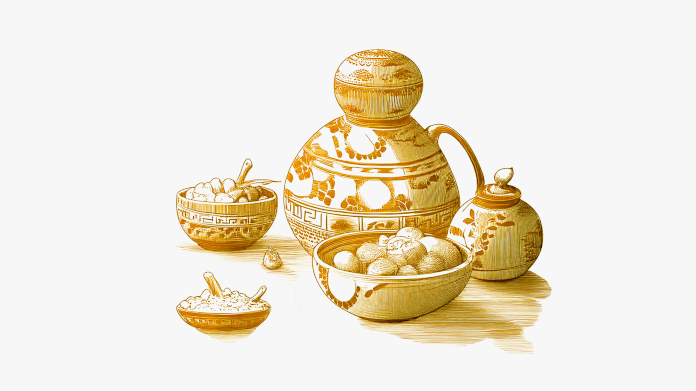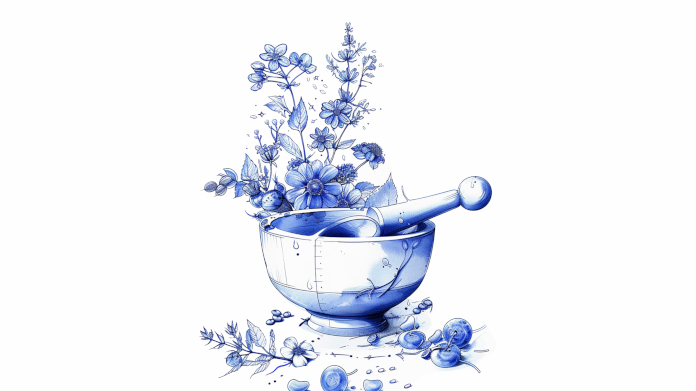Turmeric: what exactly is it, what benefits does it offer, and what’s the recommended dosage?
A plant that’s been used for thousands of years, turmeric is popular both as a cooking ingredient and as a phytotherapeutic agent. Discover its health virtues and the right dose to take to gain maximum benefit.

Turmeric: an age-old Ayurvedic plant
A key ingredient in curries, turmeric, or Curcuma longa to give it its scientific name, is a perennial plant that grows in the world’s tropical regions. It is part of the zingiberaceae family (1).
Like ginger, to which it is closely related, turmeric is primarily used for its fast-growing roots: the plant’s flowers, however magnificent, are of no culinary or medicinal interest.
Bitter, slightly spicy, light, dry, clarifying and warm, turmeric has been enjoyed as a condiment for thousands of years ... but it also features widely in phytotherapy. Like many Asian spices, it frequently crops up in Ayurveda, the ancient Indian system of medicine (2).
Tip: if you like to cook with turmeric, choose the fresh root, as it is more fragrant and subtle than the dry powder.
Spotlight on curcumin, its main active ingredient
Curcumin, a phenolic compound with low water-solubility, is the most potent active ingredient in turmeric (3).
As well as giving turmeric its distinctive, warm, ochre-yellow colour, curcumin is largely responsible for its health benefits too. It appears, in particular, to help inhibit a number of harmful molecules (4-5).
Turmeric’s many health benefits
Remarkably versatile, turmeric has important antioxidant properties (6). It also helps to:
- maintain an effective immune system and resistance to allergies (7);
- support nervous system function (8);
- maintain a healthy liver, stimulate appetite, prevent the accumulation of fat and facilitate its elimination via the liver (9-10);
- maintain healthy lungs and upper respiratory tract (11) ;
- support the formation and quality of blood, and healthy circulation(12) ;
- and maintain healthy skin (13).
Turmeric: what dose should you take for maximum benefit?
A daily dose of between 1500 mg and 3000 mg turmeric powder is generally recommended. In terms of herbal teas, drink two cups a day, infusing 1000-2000mg of turmeric in 15cl of boiling water for 15 minutes. Be aware, however, that turmeric has poor bioavailability.
An easy way of increasing your turmeric intake is to take a course of dietary supplements in capsule form (we recommend up to 2500 mg of turmeric a day):
- you could, for example, opt for micronized curcumin, a form of delivery which ensures good absorption in the blood, with Curcumin Solution (14). Take two capsules a day;
- a very popular supplement, Natural Curcuma offers a high curcumin content, compensating for the low bioavailability of this valuable polyphenol. Take 5 capsules a day;
- Or there’s Super Curcuma, which combines standardised curcuminoids with natural phosphatidylcholine for optimal absorption (15). Take 2 capsules a day.
It’s best to take these supplements with food, as turmeric is absorbed better with fat. So there you have it – all the key information on this amazing Ayurvedic spice. If you’ve been struck by the unique characteristics of this medicinal root, it simply remains for us to wish you happy turmeric supplementation!
References
- LEONG-ŠKORNIČKOVÁ, J. A. N. A., ŠÍDA, OTAKAR, WIJESUNDARA, Siril, et al. On the identity of turmeric: the typification of Curcuma longa L.(Zingiberaceae). Botanical Journal of the Linnean Society, 2008, vol. 157, no 1, p. 37-46.
- GOEL, Ajay, KUNNUMAKKARA, Ajaikumar B., et AGGARWAL, Bharat B. Curcumin as “Curecumin”: from kitchen to clinic. Biochemical pharmacology, 2008, vol. 75, no 4, p. 787-809.
- AKRAM, Muhammad, SHAHAB-UDDIN, Ahmed A., USMANGHANI, K. H. A. N., et al. Curcuma longa and curcumin: a review article. Rom J Biol Plant Biol, 2010, vol. 55, no 2, p. 65-70.
- HE, Yan, YUE, Yuan, ZHENG, Xi, et al. Curcumin, inflammation, and chronic diseases: how are they linked?. Molecules, 2015, vol. 20, no 5, p. 9183-9213.
- https://www.has-sante.fr/jcms/c_2911396/fr/helicobacter-pylori-recherche-et-traitement
- JAYAPRAKASHA, Guddadarangavvanahally Krishanareddy, RAO, L. Jaganmohan, et SAKARIAH, Kunnumpurath K. Antioxidant activities of curcumin, demethoxycurcumin and bisdemethoxycurcumin. Food chemistry, 2006, vol. 98, no 4, p. 720-724.
- JAGETIA, Ganesh Chandra et AGGARWAL, Bharat B. “Spicing up” of the immune system by curcumin. Journal of clinical immunology, 2007, vol. 27, no 1, p. 19-35.
- CONCETTA SCUTO, Maria, MANCUSO, Cesare, TOMASELLO, Barbara, et al. Curcumin, hormesis and the nervous system. Nutrients, 2019, vol. 11, no 10, p. 2417.
- RIVERA‐ESPINOZA, Yadira et MURIEL, Pablo. Pharmacological actions of curcumin in liver diseases or damage. Liver International, 2009, vol. 29, no 10, p. 1457-1466.
- PANAHI, Yunes, KIANPOUR, Parisa, MOHTASHAMI, Reza, et al. Curcumin lowers serum lipids and uric acid in subjects with nonalcoholic fatty liver disease: a randomized controlled trial. Journal of cardiovascular pharmacology, 2016, vol. 68, no 3, p. 223-229.
- LIANG, Zhaofeng, WU, Rui, XIE, Wei, et al. Curcumin reverses tobacco smoke‑induced epithelial‑mesenchymal transition by suppressing the MAPK pathway in the lungs of mice. Molecular Medicine Reports, 2018, vol. 17, no 1, p. 2019-2025.
- AWASTHI, Himani, TOTA, Santoshkumar, HANIF, Kashif, et al. Protective effect of curcumin against intracerebral streptozotocin induced impairment in memory and cerebral blood flow. Life sciences, 2010, vol. 86, no 3-4, p. 87-94.
- THANGAPAZHAM, Rajesh L., SHARMA, Anuj, et MAHESHWARI, Radha K. Beneficial role of curcumin in skin diseases. In : The molecular targets and therapeutic uses of curcumin in health and disease. Springer, Boston, MA, 2007. p. 343-357.
- SCHIBORR, Christina, KOCHER, Alexa, BEHNAM, Dariush, et al. The oral bioavailability of curcumin from micronized powder and liquid micelles is significantly increased in healthy humans and differs between sexes. Molecular nutrition & food research, 2014, vol. 58, no 3, p. 516-527.
- ANAND, Preetha, KUNNUMAKKARA, Ajaikumar B., NEWMAN, Robert A., et al. Bioavailability of curcumin: problems and promises. Molecular pharmaceutics, 2007, vol. 4, no 6, p. 807-818.
Keywords
8 Hours
Good delivery and flawless quality
AS far as delivery and the visual quality are concerned, Supersmart is excellent. I will not comment on the efficacy of the products themselves, since that is only possible over a longer period and in a large customer base compared to people who do not consume a particular product.
Roger De Backer
1 Days
Perfect services
Perfect services, perfect support, great articles about products
Michaela Alali Beitlová
2 Days
Great experience and effective supplements
I’ve purchased many types of supplements from this company over the course of years to treat a few issues, and I’m satisfied with their quality. After using them consistently for a period of time, I can say they met my expectations and I could feel real health benefits that built up over time. Deliveries are always quick. I recommend this company to anyone looking for high-quality supplements.
Giordano
2 Days
Es hat alles gestimmt
Es hat alles gestimmt. Top
marina thieme
5 Days
Great product
Great product, but still evaluating its effectiveness. Highly recommended. Super efficient delivery.
Chalise
9 Days
Quality products
Quality products , efficient and effective customer service. You can’t ask more
CLaudia
15 Days
Good quality product and customer service.
So far, I'm liking this product, and the customer service was very good.
ELZL
22 Days
The products I use are excel·lent
The products I use are excel·lent
ROSAS Josep Maria
30 Days
Delivery is prompt and I never saw a…
Delivery is prompt and I never saw a quality problem with the manufacturing. It is not possible to assess efficacy on a personal basis, since too many factors come into play. Efficacy can only be assessed statistically with a sufficient number of cases.
Roger De Backer
31 Days
I collaborates with the Supersmart…
I collaborates with the Supersmart more than 10 years. Every thing is going good. Quality of the things is good. Delivery comes in time. Five stars definitely !!!
Oleksiy
31 Days
All good
Simple, frictionless site, easy ordering, good delivery updates and execution.
Chris Robbins
33 Days
I feel better
I feel better
Peter Ammann
33 Days
Prompt delivery
Prompt delivery
JAKUB Radisch
34 Days
My new go-to for top quality supplements!
I am buying more and more of my supplements from this superb, high quality company. Cannot recommend it enough. Plus, excellent customer service with a quick, helpful team and speedy deliveries. Highly recommend Supersmart!
Cecilie H.
38 Days
SUPERSMART WHAT ELSE👍
SUPERSMART WHAT ELSE👍
DIEDERLE Christophe
of experience
your money back
##montant## purchase



